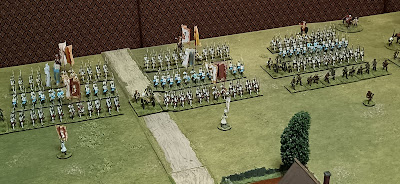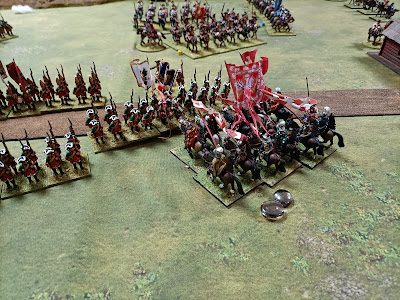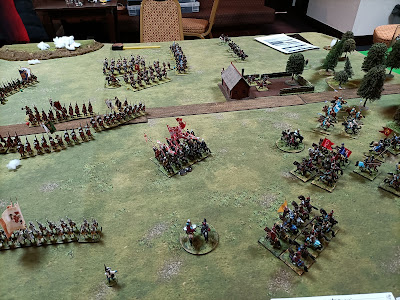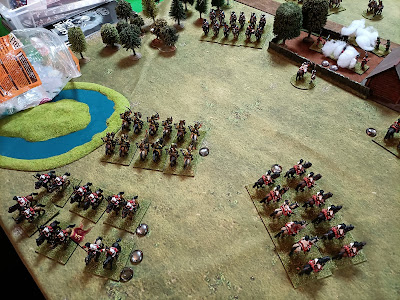We are back near Warsaw, but this time it's a hundred years later. This is the fictional setting of my Second War of Polish Succession and its final battle. We utilized our entire collection from that period and some proxy miniatures. Our game was played using rules written by Michael, the Seven Years.
UMPIRING: Michael Schneider, Bartek Żynda
1. Forces.
3 x Grenadiers1 x Regimental Gun
3 x Musketeers1 x Regimental Gun
2 x Musketeers1 x Regimental Gun
3 x Grenadiers1 x Private Polish Infantry1 x Regimental Gun
3 x Musketeers1 x Regimental Gun
3 x Musketeers1 x Regimental Gun
1 x Cuirassiers1 x Dragoons
1 x Dragoons1 x Hussars2 x Foot Skirmishers
1 x Husaria2 x Pancerni
3 x Noble Volunteers Cavalry
2 x Uhlan1 x Horse Skirmishers
3 x Medium Gun
2 x Medium Gun
3 x Grenadiers1 x Regimental Gun
3 x Musketeers1 x Regimental Gun
3 x Musketeers1 x Regimental Gun
3 x Grenadiers1 x Regimental Gun
3 x Musketeers1 x Regimental Gun
3 x Musketeers1 x Regimental Gun
1 x Cuirassiers1 x Hussars1 x Foot Skirmishers
1 x Dragoons1 x Hussars1 x Foot Skirmishers
1 x Cuirassiers1 x Dragoons1 x Foot Skirmishers
1 x Dragoons1 x Hussars1 x Foot Skirmishers
3 x Medium Gun
2 x Medium Gun1 x Light Gun
2. The Game.
After the recent indecisive battle at Pludraki, the Saxon-Polish troops finally reached Warsaw. In this city, the Election Sejm convened to elect the Saxon elector as the new king of the Polish-Lithuanian Commonwealth. While the Sejm was in progress, Austrian reinforcements arrived near Warsaw, which boosted the morale of those supporting August Frederick. Additionally, it was discovered that Russian and Prussian troops had once again gathered on the other side of the Vistula River. As a result, it was decided to launch an attack against them.
When the two armies met, the Saxon supporters were surprised to find that the Russians and Prussians were occupying a fortified hill. Nevertheless, it was decided to launch an assault on these positions. The Austrians were positioned on the left flank, the Saxons in the centre, and the Poles on the right flank. The plan was to strike the fortifications directly with the infantry, while the cavalry would attack the flanks and move to the rear of the enemy to surround and defeat them.
The battle began with cavalry engaging on the flanks. The Polish light cavalry manoeuvred around the right village and entered the rear of the Russian cavalry. In response, the Russian forces attacked the regular Polish units and the Volunteers. Although the regular units successfully repelled the Russian attack, two Volunteer units were defeated, which meant they could no longer actively participate in the battle and could only support the actions of the regular cavalry. Meanwhile, remarkable events were unfolding on the side of the Polish light cavalry. They faced resistance from Russian skirmishers, but one of the Uhlan units managed to break through the Russian lines and began to cause chaos in their rear.
The situation on the other side was entirely different. The Austrian skirmishers captured the left village but were soon attacked by the Prussian skirmishers. The struggle for control of the village continued almost until the battle's end, with the Austrians ultimately pushing the Prussians back at a significant cost to both sides. Similarly, in the cavalry engagements, neither the Prussians nor the Austrians managed to secure an advantage, resulting in a series of relentless charges and countercharges.
Meanwhile, in the centre, under the cover of cannon fire, Austrian and Saxon troops advanced toward the fortified hill. However, the Russians were quicker and managed to capture the large central village, which complicated the effort to flank the position on the hill. In the open field, they began to suffer heavy casualties from the fire of Prussian and Russian cannons. The Saxon-Polish grenadier brigade endured particularly severe losses, being annihilated by this barrage.
The battle was reaching its peak. First, the Uhlans attacked the Prussian rear, targeting their cannons from behind. This move forced the Puszcza infantry to shift positions and protect their rear, though the attack was ultimately unsuccessful. On the right flank, the Polish cavalry began to gain the upper hand against the Russian cavalry, but it wasn't enough to turn the tide of the battle. In the end, neither side was prepared to launch a decisive attack. The final charge of the husaria occurred here. It forced the Russian cavalry to retreat but did not defeat them. Perhaps if they had used lances, it could have been a victorious charge.
That marked the end of the good news. On our left flank, the disorganized Austrian cuirassiers had exited the battlefield, which significantly weakened our position. Although they managed to hold their ground and repel the last Prussian attack, the situation did not look promising.
The outcome of the battle was determined in the centre. The Saxons were unable to break through the Russian defences, prompting the Austrians to launch their attack. However, their advance was halted by the Prussians, who inflicted significant losses on the Austrians. This setback caused the Austrians to enter negotiations with the Prussians, signalling the end of the battle. The faction supporting the Saxons for the Polish throne was defeated. Now, under Russian authority, the Sejm will elect Stanisław August Poniatowski as king. History is returning to its rightful course.
The Second War of the Polish Succession ended, but neither the Saxons nor the Polish army were defeated. The election of Stanisław August Poniatowski did not resolve the unrest in the country. Before long, the Bar Confederation Uprising erupted. In my vision of this period, however, the uprising will be more extensive. This is where my project begins: to depict the Polish army of that era.
 |
| 8:2 in big units and 3:2 in guns for Prussians and Russians. |
Currently, I am researching the figures I will be using, and I am pleased to note that I will likely be able to convert nearly all of my 17th-century cavalry for this conflict. However, the banners will need to be replaced. Additionally, I will need to paint a new Husaria, as the one I currently have is outdated. I have a plan, so I will keep the topic open for further exploration.
3. Links.
MICHAEL:
FLICKR:
https://www.flickr.com/photos/asienieboje/albums/72177720323717677






















































Ależ niecodzienny teatr działań! Ale tym lepiej się czyta i ogląda!
OdpowiedzUsuńBardzo niecodzienny. Ale bardzo wdzięczny wargamingowo.
Usuń